by Piter Kehoma Boll
Now that I finished introducing Linnaeus classification of animals (see here parts 1, 2, 3, and 4), it’s time to talk about the plants. This is Part 1. See here parts 2, 3, 4, 5, 6 and 7.
Linnaeus’ classification of plants actually started a little bit earlier than that of animals, in his work Species Plantarum published in 1753. The system he used there, however, did not change very much from the one presented in the 10th edition of Systema Naturae, so I’ll begin from there, so that they will be following animals at the same pace.
If you have a considerable knowledge on living beings, you can easily notice that plants are much more “regular” in anatomy than animals. Even though plants are usually assymetrical, branched and with temporary organs, they all have basically the same general structure composed by a root, a stem, leaves and reproductive organs.
Linnaeus struggled to find ways to classify animals based on the same organs in all groups. As a result, his classification of animals had an “ugly” tree structure. There were 6 classes, each with different orders, i.e., it was impossible for him to use the same criteria to define the orders of mammals that he used to define orders of birds or worms, but in plants that worked and, as a result, the classification of plants had a “beautiful” table structure.
The 24 classes of plants were based primarily on the number of male sexual organs. The orders, on the other hand, were based on the number of female sexual organs. As a result, orders are not exactly subordinate to classes, but coexist with them in a “crossed”, tabular way.
1. Monandria (“single male”)
“A single husband in the marriage”, i.e., a single stamen in a hermaphrodite flower.
1.1 Monandria monogynia (“single male and single female”), a single stamen and a single pistil in a hermaphrodite flower: Canna (canna lilies), Amomum (gingers and cardamoms), Costus (spiral gingers), Alpinia (ginger lilies), Maranta (arrowroots), Curcuma (turmeric and Chinese ginger), Kaempferia (sand gingers), Thalia (alligator flags), Boerhavia (spiderlings), Salicornia (glasswort), Hippuris (mare’s tails).

These eleven species were classified by Linnaeus as Monandria Monogynia, having “monogamic flowers” (from left to right, top to bottom): Canna indica, garden ginger (Amomum zingiber, now Zingiber officinalis), Arabic spiral ginger (Costus arabicus), Lesses Antilles’ ginger lily (Alpinia racemosa, now Renealmia pyramidalis), West Indian arrowroot (Maranta arundinacea), turmeric (Curcuma longa), sand ginger (Kaempferia galanga), bent alligator flag (Thalia geniculata), erect spiderling (Boerhavia erecta), common glasswort (Salicornia europaea), common mare’s tail (Hippuris vulgaris). Credits to Wikimedia user Asio otus (Canna), Reinaldo Aguilar (garden ginger), Smithsonian Institute (spiral ginger, ginger lily, sand ginger), Alexis López Hernández (arrowroot), H. Zell (turmeric, mare’s tail), Meneerke Bloem (alligator flag), J. M. Garg (spiderling), Wikimedia user Ghislain18 (glasswort).
1.2 Monandria digynia (“single male and two females”), a single stamen and two pistils in a hermaphrodite flower: Corispermum (bugseeds), Callitriche (water starworts), Blitum (goosefeet), Cinna (woodreeds).

The order Monandria Digynia, “a husband with two wives”, included the following species (from left to right): hyssop-leaved bugseed (Corispermum hyssopifolium), common water starwort (Callitriche palustris), strawberry goosefoot (Blitum capitatum), sweet woodreed (Cinna arundinacea). Credits to Yu Ito (water starwort), Derek Ramsey (goosefoot), John Hilty (woodreed).
2. Diandria (“two males”)
“Two husbands in each marriage”, i.e., two stamens in a hermaphrodite flower.
2.1 Diandria Monogynia (“two males and single female”), two stamens and a single pistil in a hermaphrodite flower: Nyctanthes (jasmines), Jasminum (more jasmines), Ligustrum (privets), Phyllirea (mock privets), Olea (olives), Chionanthus (fringetrees), Syringa (lilacs), Eranthemum (blue sages), Circaea (enchanter’s nightshades), Veronica (speedwells), Justicia (shrimp plants), Dianthera (water willows), Gratiola (hedgehyssops), Pinguicula (butterworts), Utricularia (bladderworts), Verbena (vervains), Lycopus (gypsyworts), Amethystea (Indian gems), Ziziphora (ziziphores), Monarda (bergamots), Rosmarinus (rosemary), Salvia (sages), Collinsonia (ox-balm), Morina (whorlflower).
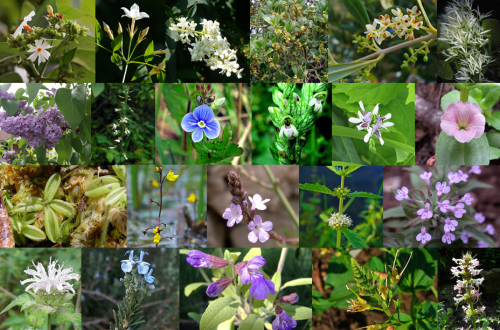
The order Diandria Monogynia, “two husbands and a wife”, included the following species (from left to right, top to bottom): night-flowering jasmine (Nyctanthes arbor-tristis), common jasmine (Jasminum officinale), common privet (Ligustrum vulgare), mock privet (Phillyrea latifolia), olive (Olea europaea), white fringetree (Chionanthus virginicus), common lilac (Syringa vulgaris), Paris enchanter’s nightshade (Circaea lutetiana), bird’s-eye speedwell (Veronica chamaedrys), squirrel’s tail (Justicia betonica), American water-willow (Dianthera americana, now Justicia americana), Austral brooklime (Gratiola peruviana), pale butterwort (Pinguicula lusitanica), common bladderwort (Utricularia vulgaris), common vervain (Verbena officinalis), gypsywort (Lycopus europaeus), headed ziziphore (Ziziphora capitata), bee balm (Monarda fistulosa), rosemary (Rosmarinus officinalis), common sage (Salvia officinalis), ox-balm (Collinsonia canadensis), prickly whorlflower (Morina persica). Credits to J. M. Garg (night-flowering jasmine), Wikimedia user Pancrat (jasmine), Andrew Butko (privet), legambientearcipelagotoscano.it (mock privet), H. Zell (olive, gypsywort, ox-balm), Ranko Tomić (lilac), Wikimedia user Pethan (enchanter’s nightshade, whorlflower), Wikimedia user Algirdas (speedwell), India Biodiversity Portal (squirrel’s tail), flickr user peganum (water-willow), John Tann (brooklime), Noah Elhardt (butterwort), Christian Fischer (bladderwort), Denis Barthel (vervain), Gideon Pisanty (ziziphore), Kurt Stüber (bee balm), Giancarlo Dessi (rosemary), Wikimedia user Duk (sage).
2.2 Diandria Digynia (“two males and two females”), two stamens and two pistils in a hermaphrodite flower: Paspalum (paspalums), Anthoxanthum (vernal grasses), Bufonia (bufonias).
2.3 Diandria Trigynia (“two males and three females”), two stamens and three pistils in a hermaphrodite flower: Piper (peppers and radiator plants).
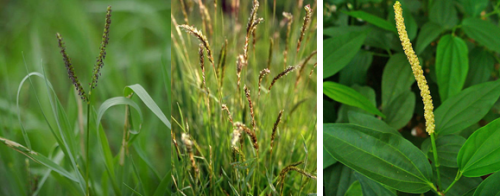
The two first species (from left to right) were included in the order Diandria Digynia: knotgrass (Paspalum distichum) and sweet vernal grass (Anthoxanthum odoratum). The last species, the black pepper (Piper nigrum) was in the order Diandria Trigynia. Credits to Wikimedia user Keisotyo (knotgrass), Christian Fischer (vernal grass), H. Zell (pepper).
3. Triandria (“three males”)
“Three husbands in each marriage”, i.e., three stamens in a hermaphrodite flower.
3.1 Triandria Monogynia (“three males and one female”), three stamens and one pistil in a hermaphrodite flower: Valeriana (valerians), Hirtella (pigeon berries), Olax (mella), Tamarindus (tamarind), Cneorum (spurge olive), Comocladia (maidenplums), Melothria (creeping cucumber), Ortegia (ortegias), Loeflingia (pygmyleaves), Polycnemum (needleleaves), Cassytha (love vines), Crocus (crocuses), Ixia (corn lilies, irises, harlequin flowers), Gladiolus (sword lilies), Antholyza (sword lilies, bugle-lilies, etc), Iris (irises), Wachendorfia (redroots), Commelina (dayflowers and spiderworts), Xyris (yelloweyed grasses), Schoenus (bogrushes, pricklegrasses and sawgrasses), Cyperus (sedges), Scirpus (clubrushes and spikerushes), Eriophorum (cottongrasses), Nardus (matgrass), Lygeum (esparto grass).

These 22 species were classified by Linnaeus as Triandria Monogynia (from left to right, top to bottom): garden valerian (Valeriana officinalis), pigeon berry (Hirtella americana), tamarind (Tamarindus indica), spurge olive (Cneorum tricoccon), creeping cucumber (Melothria pendula), Spanish ortegia (Ortegia hispanica), field needleleaf (Polycnemum arvense), love vine (Cassytha filiformis), saffron crocus (Crocus sativus), harlequin flower (Ixia bulbifera, now Sparaxis bulbifera), long-tubed painted lady (Gladiolus angustus), bulbil bugle-lily (Antholyza meriana, now Watsonia meriana), bearded iris (Iris germanica), straw redroot (Wachendorfia paniculata), common dayflower (Commelina communis), Indian yelloweyed grass (Xyris indica), black bogrush (Schoenus nigricans), papyrus (Cyperus papyrus), floating clubrush (Scirpus fluitans, now Isolepis fluitans), hare’s-tail cottongrass (Eriophorum vaginatum), matgrass (Nardus stricta), esparto grass (Lygeum spartum). Credits to Kurt Stüber (valerian, papyrus), INBio Costa Rica (pigeon berry), Wikimedia user Tau’olonga (tamarind), Jean Tosti (spurge olive), Smithsonian Institute (creeping cucumber), Luis Fernández García (ortegia), Mark Marathon (love vine), Wikimedia user KENPEI (crocus, bearded iris), Wikimedia user Ixitixel (harlequin flower), Andrew Massy (painted lady), Forest & Kim Starr (bugle-lily), Ori Fragman-Sapir (redroot), Bogdan Giușcă (dayflower), Wikimedia user Quoilp (yelloweyed grass), Yu Ito (clubrush), Kristian Peters (cottongrass), James K. Lindsey (matgrass), Wikimedia user Nanosanchez (esparto grass).
3.2 Triandria Digynia (“three males and two females”), three stamens and two pistils in an hermaphrodite flower: Bobartia (bobartias), Cornucopiae (hooded grasses), Saccharum (sugar cane), Phalaris (canarygrasses and cutgrasses), Panicum (panicgrasses and barnyard grasses), Phleum (cat’s-tails), Alopecurus (foxtail grasses), Milium (milletgrass), Agrostis (bentgrasses), Aira (hairgrasses), Melica (melicgrasses), Poa (meadowgrasses), Briza (quaking grasses), Uniola (sea oats), Dactylis (cocksfeet), Cynosurus (dogstail grasses), Festuca (fescues), Bromus (bromes), Stipa (feather grasses), Avena (oats and oatgrasses), Lagurus (hare’s tail), Arundo (canes, bamboos, reeds), Aristida (three-awns and grama grasses), Lolium (ryegrasses), Elymus (wild ryes), Secale (ryes), Hordeum (barleys), Triticum (wheats).
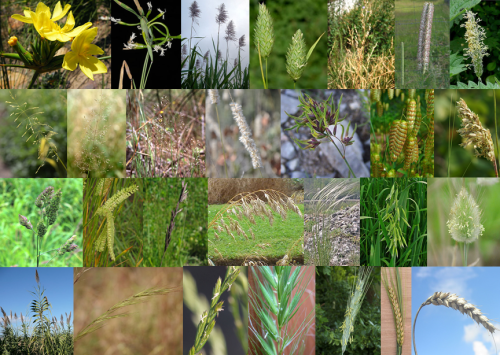
Among the species making up the order Triandria Digynia were (from left to right, top to bottom): Indian bobartia (Bobartia indica), common hooded grass (Cornucopiae cucullatum), sugar cane (Saccharum officinarum), common canarygrass (Phalaris cannariensis), switchgrass (Panicum virgatum), timothy-grass (Phleum pretense), meadow foxtail (Alopecurus pratensis), wood millet (Milium effusum), common bent (Agrostis capillaris), silver hairgrass (Aira caryophyllea), hairy melic (Melica ciliata), Alpine meadowgrass (Poa alpina), big quaking grass (Briza maxima), sea oat (Uniola paniculata), cock’s foot (Dactylis glomerata), crested dog’s-tail (Cynosurus cristatus), red fescue (Festuca rubra), rye brome (Bromus secalinus), European feather grass (Stipa pennata), common oat (Avena sativa), hare’s tail (Lagurus ovatus), giant cane (Arundo donax), six-weeks three-awn grass (Aristida adscensionis), perennial ryegrass (Lolium perenne), Canada wild rye (Elymus canadensis), rye (Secale cereale), barley (Hordeum vulgare), common wheat (Triticum aestivum). Credits to Andrew Massyn (bobartia), Ori Fragman-Sapir (hooded grass), Bruno Navez (sugar cane), biopix.com (canarygrass), Kelly O’Donnell (switchgrass), Wikimedia user Rasbak (timothy-grass, foxtail, crested dog’s-tail, ryegrass, rye, barley), Gustav Svensson (millet), James K. Lindsey (bent), Wikimedia user Xemenendura (melic), Jerzy Opiła (meadowgrass), H. Zell (quaking grass, oat), Hans Hillewaert (sea oat), flickr user foxypar4 (cock’s foot), Kristian Peters (fescue), Kurt Stüber (rye brome, hare’s tail), Wikimedia user Prazak (feather grass), Peter Forster (giant cane), Marco Schmidt (three-awn grass), Matt Lavin (wild rye), Petr Filippov (wheat).
3.3 Triandria Trigynia (“three males and three females”), three stamens and three pistils in a hermaphrodite flower: Eriocaulon (pipeworts), Montia (blinks), Proserpinaca (mermaidweeds), Triplaris (ant tree), Holosteum (jagged chickweeds), Polycarpon (allseeds), Mollugo (carpetweeds), Minuartia (sandworts), Queria (more sandworts), Lechea (pinweeds).
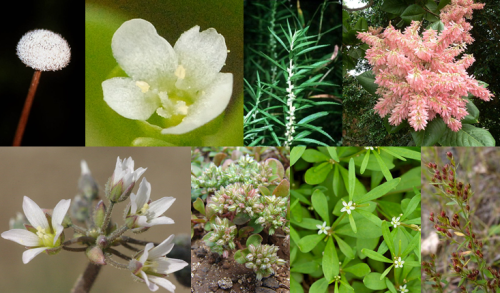
These 8 species were in the order Triandria Trigynia (from left to right, top to bottom): ten-angled pipewort (Eriocaulon decangulare), water blink (Montia fontana), marsh mermaidweed (Proserpinaca palustris), ant tree (Triplaris americana), jagged chickweed (Holosteum umbellatum), four-leaved allseed (Polycarpon tetraphyllum), green carpetweed (Mollugo verticillata), thymeleaf pinweed (Lechea minor). Credits to James K. Lindsey (blink), Wikimedia user JMK (ant tree), Forest & Kim Starr (allseed), Wikimedia user Eric in SF (carpetweed), John Hility (pinweed).
4. Tetrandria (“four males”)
“Four husbands in each marriage”, i.e., four stamens in a hermaphrodite flower.
4.1 Tetrandria Monogynia (“four males and one female”), four stamens and one pistil in a hermaphrodite flower: Leucadendron (sugar bushes), Protea (silver trees), Cephalanthus (buttonbushes), Globularia (globe daisies), Dipsacus (teasels), Scabiosa (scabioses), Knautia (more scabioses), Allionia (windmills), Hedyotis (starviolets), Spermacoce (false buttonweeds), Sherardia (field madders), Asperula (woodruffs), Diodia (buttonweeds), Knoxia (knoxia), Houstonia (bluet), Galium (bedstraws), Crucianella (crossworts), Rubia (madders), Fuchsia (fuchsias), Siphonanthus (Turk’s turban), Catesbaea (Lily thorn), Ixora (jungle flames), Scurrula (metrosexuals), Pavetta (pavettas), Avicennia (mangroves), Petesia (tropicroses), Mitchella (partridge berries), Callicarpa (beautyberries), Polypremum (juniperleaf), Penaea (leatherleaves), Blaeria (Blair’s heath), Buddleja (butterfly bushes), Exacum (tropicbouquets), Plantago (plantains), Scoparia (broomworts), Rhacoma (maidenberry), Centunculus (chaffweed), Sanguisorba (burnets), Cissus (sorrelvines), Epimedium (barrenworts), Cornus (dogwoods), Fagara (wild limes), Tomex (Malayan lilac), Ptelea (hoptrees), Ludwigia (water primroses), Oldenlandia (chay roots), Ammannia (redstems), Isnardia (water purslane), Trapa (water caltrop), Dorstenia (contrayervas), Elaeagnus (silverberries), Brabejum (wild almond), Krameria (rhatanies), Rivina (pigeonberry and hoopvine), Salvadora (toothbrush tree), Camphorosma (camphorwort), Alchemilla (lady’s mantles).
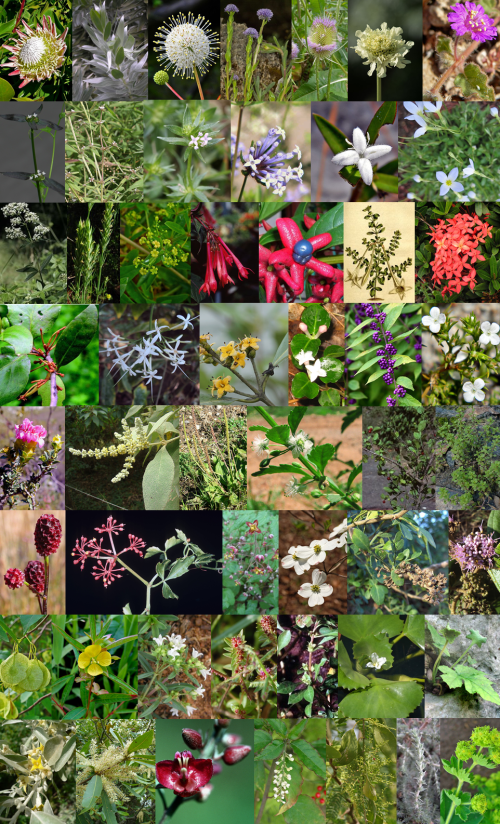
The diverse order Tetrandria Monogynia included many species, such as (from left to right, top to bottom): king sugar bush (Leucadendron cynaroides, now Protea cynaroides), silver leaf tree (Protea argentea, now Leucadendron argenteum), common buttonbush (Cephalanthus occidentalis), common ball flower (Globularia bisnagarica), wild teasel (Dipsacus fullonum), yellow scabiose (Scabiosa alpina, now Cephalaria alpina), common windmill (Allionia incarnata), ear starviolet (Hedyotis auricularia), slender false buttonweed (Spermacoce tenuior), blue field madder (Sherardia arvensis), blue woodruff (Asperula arvensis), Virginia buttonweed (Diodia virginiana), azure bluet (Houstonia caerulea), European bedstraw (Galium rubioides), narrowleaf crosswort (Crucianella angustifolia), common madder (Rubia tinctorum), three-leaved fuchsia (Fuchsia triphylla), Turk’s turban (Siphonanthus indicus, now Clerodendron indicum), lily thorn (Catesbaea spinosa), common jungle flame (Ixora coccinea), metrosexual (Scurrula parasitica), Indian pavetta (Pavetta indica), Indian mangrove (Avicennia officinalis), partridge berry (Mitchella repens), American beautyberry (Callicarpa americana), juniperleaf (Polypremum procumbens), cup leatherleaf (Penaea sarcocolla, now Saltera sarcocolla), American butterfly bush (Buddleja americana), greater plantain (Plantago major), sweet broom (Scoparia dulcis), maidenberry (Rhacoma crossopetalum, now Crossopetalum rhacoma), chaffweed (Centunculus minimus, now Lysimachia minima), great burnet (Sanguisorba officinalis), sorrelvine (Cissus trifoliata), Alpine barrenwort (Epimedium alpinum), flowering dogwood (Cornus florida), wild lime (Fagara pterota, now Zanthoxylum fagara), great wooly Malayan lilac (Tomex tomentosa, now Callicarpa tomentosa), common hoptree (Ptelea trifoliata), rattlebox (Ludwigia alternifolia), chay root (Oldenlandia umbellata), monarch redstem (Ammannia baccifera), water purslane (Isnardia palustris, now Ludwigia palustris), water caltrop (Trapa natans), true contrayerva (Dorstenia contrajerva), senjed (Elaeagnus angustifolia), wild almond (Brabejum stellatifolium), abrojo Colorado (Krameria ixine), pigeonberry (Rivina humilis), toothbrush tree (Salvadora persica), common camphorwort (Camphorosma monspeliaca), common lady’s mantle (Alchemilla vulgaris). Credits to Stan Shebs (sugar bush, windmill, plantain), Wikimedia user Chinasaur (silver leaf tree), Bob Peterson (buttonbush, buttonweed, juniperleaf), Hedwig Storch (ball flower), Muriel Bendel (teasel), Wikimedia user Dinkum (scabiose), flickr user john_amend_all2000 (starviolet), Smithsonian Institute (false buttonweed, fuchsia, maidenberry, sorrelvine, abrojo colorado), Wikimedia user Strobilomyces (field madder), Kurt Süber (woodruff), Rob Duval (bluet), Jan Ševčík (bedstraw), Michael Kesl (crosswort), H. Zell (madder, hoptree, lady’s mantle), Forest & Kim Starr (Turk’s turban), Louise Wolff (jungle flame), Indian Biodiversity Portal (metrosexual), Wikimedia user Vinayaraj (pavetta, Malayan lilac), Wikimedia user Vengolis (Indian mangrove), Wikimedia user Jomegat (partridge berry), John Murphy (beautyberry), Wikimedia user Nanosanchez (leatherleaf), Dick Culbert (butterfly bush), Alex Popovkin (chaffweed), Wikimedia user Anonymous Powered (burnet), Christian Hummert (barrenwort), Derek Ramsey (dogwood), flickr user homeredwardprice (wild lime), Fritz Flohr Reynolds (rattlebox), flickr user Lalithamba (chay root), Jayesh Patil (redstem), George Shramayr (water caltrop), Jim Conrad (contrayerva), Georg Slickers (senjed), Andew Massyn (wild almond), Wikimedia user KENPEI (pigeonberry), J. M. Garg (toothbrush tree), Muséum National d’Histoire Naturelle. Service du Patrimoine Naturel (camphorwort).
4.2 Tetrandria digynia (“four males and two females”), four stamens and two pistils in a hermaphrodite flower: Aphanes (parsley-piert), Cruzeta (Juba’s bush), Hamamelis (witch-hazel), Cuscuta (dodders), Hypecoum (wingpoppies).

The order Tetrandria Digynia included (from left to right) the common parsley-piert (Aphanes arvensis), the Juba’s bush (Cruzeta hispanica, now Iresine diffusa), the common witch-hazel (Hamamelis virginiana), the European dodder (Cuscuta europaea), and the prostrate wingpoppy (Hypecoum procumbens). Credits to Wikimedia user Kenraiz (parsley-piert), Dick Culbert (Juba’s bush), Wikimedia user BotBln (witch-hazel), Michael Becker (dodder), Javier Martin (wingpoppy).
4.3 Tetrandria tetragynia (“four males and four females”), four stamens and four pistils in a hermaphrodite flower: Ilex (hollies), Coldenia (coldenias), Potamogeton (pondweeds), Ruppia (ditchgrasses), Sagina (pearlworts), Tillaea (pygmyweeds).
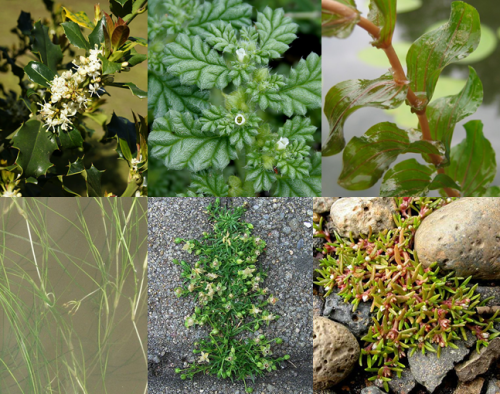
Linnaeus classified as Tetrandria Tetragynia (from left to right, top to bottom) the European holly (Ilex aquifolium), prostrate coldenia (Coldenia procumbens), claspingleaf pondweed (Potamogeton perfoliatus), ditchgrass (Rupia maritima), matted pearlwort (Sagina procumbens), and water pygmyweed (Tillaea aquatica, now Crassula aquatica). Credits to Hans Hillewaert (holly), J. M. Garg (coldenia), Kristian Peters (pondweed), Yu Ito (ditchgrass), Wikimedia user Density (pearlwort), Hörður Kristinsson (pygmyweed).
That is all for now, but there is a lot more to show. As one can clearly see, Linnaeus’ knowledge on plants was astonishingly higher than his knowledge on animals, afterall, he was a botanist and not a zoologist.
– – –
References:
Linnaeus, C. (1758) Systema Naturae per regna tria Naturae…
– – –

All images are licensed under a Creative Commons Attribution-ShareAlike 4.0 International License.

Pingback: The history of Systematics: Plants in Systema Naturae, 1758 (Part 2) | Earthling Nature
Pingback: The history of Systematics: Plants in Systema Naturae, 1758 (Part 3) | Earthling Nature
Pingback: The history of Systematics: Plants in Systema Naturae, 1758 (Part 4) | Earthling Nature
Pingback: The history of Systematics: Plants in Systema Naturae, 1758 (Part 5) | Earthling Nature
Pingback: The history of Systematics: Plants in Systema Naturae, 1758 (Part 6) | Earthling Nature
Pingback: The history of Systematics: Plants in Systema Naturae, 1758 (Part 7) | Earthling Nature
Pingback: The history of Systematics: Plants in Systema Naturae, 1758 (Part 8) | Earthling Nature
Pingback: The history of Systematics: Systema Naturae from 1758 to 1767-1770 | Earthling Nature